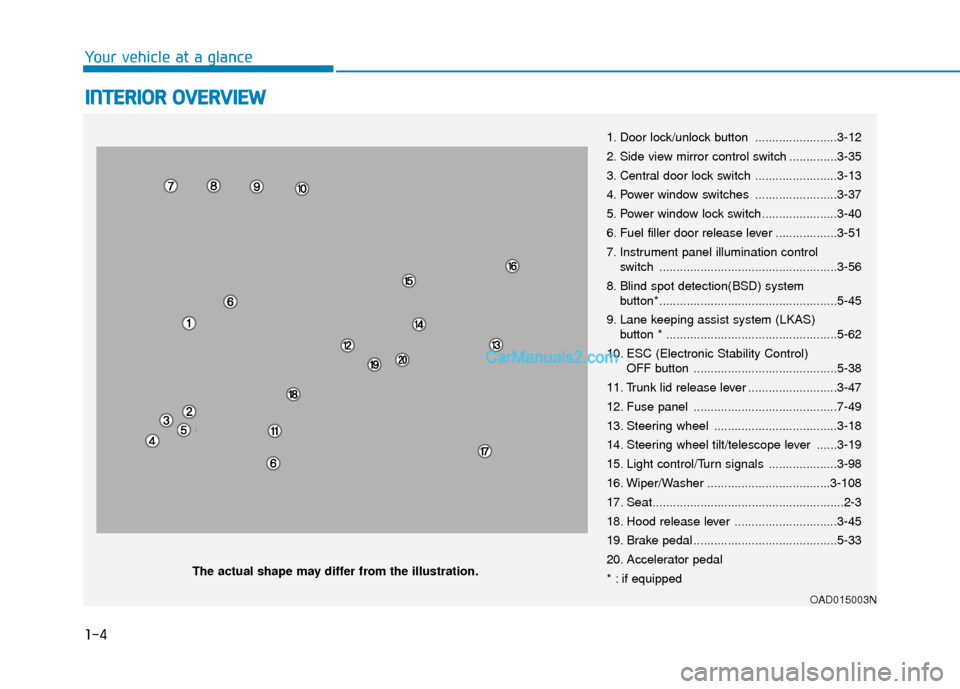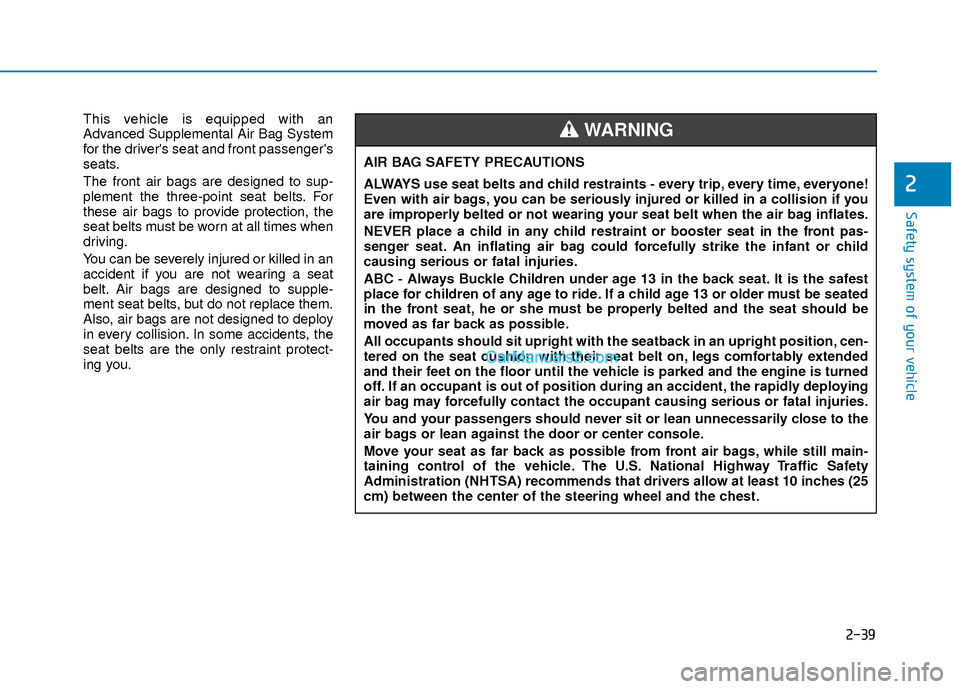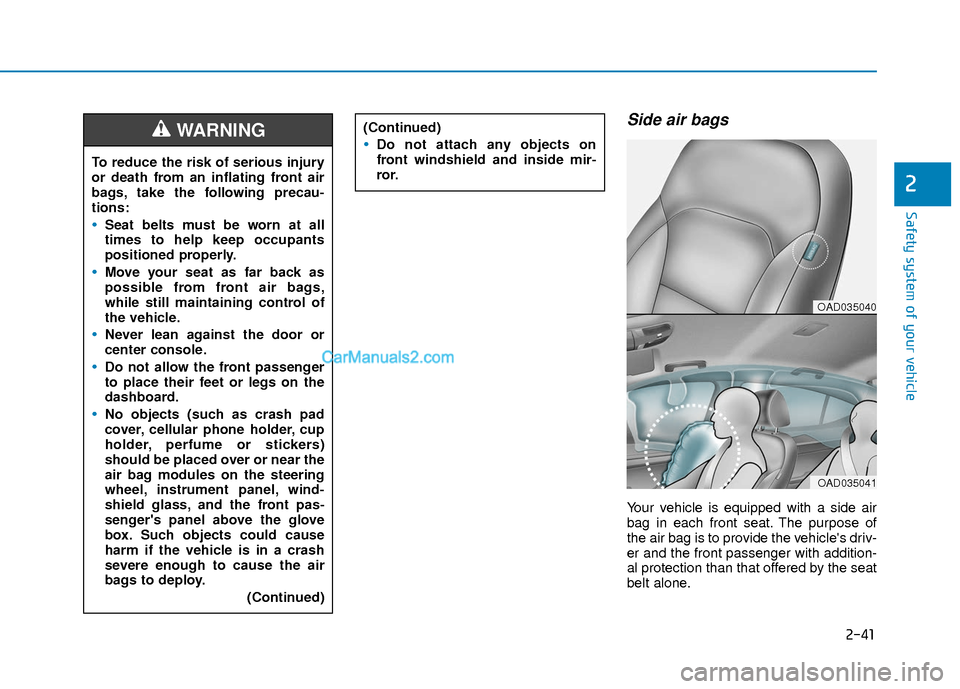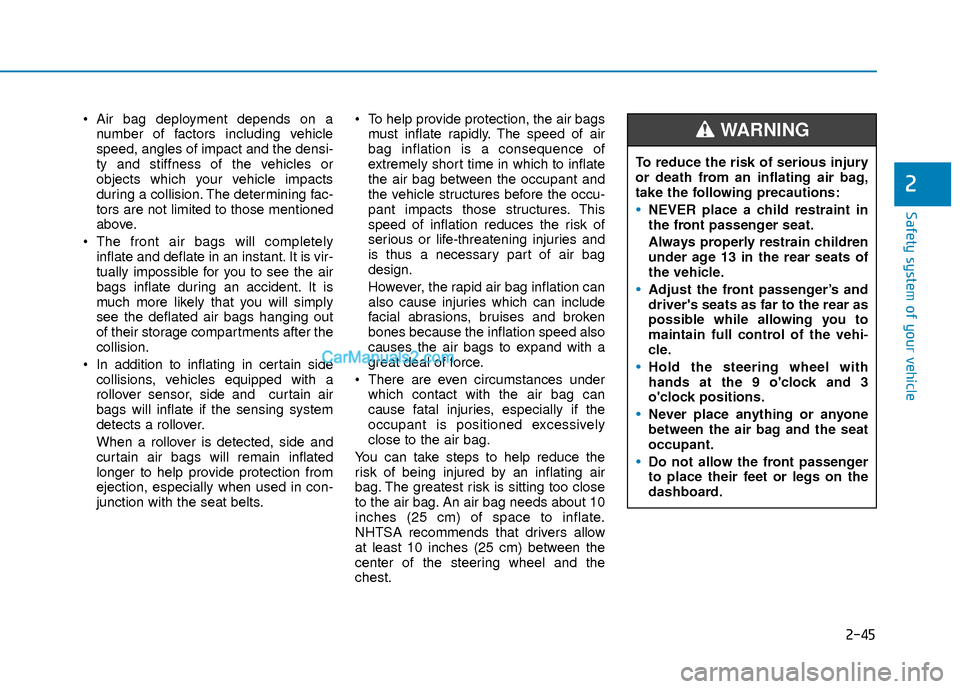steering Hyundai Elantra 2018 Owner's Manual
[x] Cancel search | Manufacturer: HYUNDAI, Model Year: 2018, Model line: Elantra, Model: Hyundai Elantra 2018Pages: 526, PDF Size: 17.2 MB
Page 15 of 526

1-4
Your vehicle at a glance
I
IN
N T
TE
ER
R I
IO
O R
R
O
O V
VE
ER
R V
V I
IE
E W
W
1. Door lock/unlock button ........................3-12
2. Side view mirror control switch ..............3-35
3. Central door lock switch ........................3-13
4. Power window switches ........................3-37
5. Power window lock switch......................3-40
6. Fuel filler door release lever ..................3-51
7. Instrument panel illumination control
switch ....................................................3-56
8. Blind spot detection(BSD) system button* ....................................................5-45
9. Lane keeping assist system (LKAS) button * ..................................................5-62
10. ESC (Electronic Stability Control) OFF button ..........................................5-38
11. Trunk lid release lever ..........................3-47
12. Fuse panel ..........................................7-49
13. Steering wheel ....................................3-18
14. Steering wheel tilt/telescope lever ......3-19
15. Light control/Turn signals ....................3-98
16. Wiper/Washer ....................................3-108
17. Seat........................................................2-3
18. Hood release lever ..............................3-45
19. Brake pedal ..........................................5-33
20. Accelerator pedal
* : if equipped
OAD015003N
The actual shape may differ from the illustration.
Page 16 of 526

I
IN
N S
ST
T R
R U
U M
M E
EN
N T
T
P
P A
A N
N E
EL
L
O
O V
VE
ER
R V
V I
IE
E W
W
The actual shape may differ from the illustration.
1-5
Your vehicle at a glance
1
1. Steering wheel audio controls*/Bluetooth®wireless technology
hands-free controls* ......................4-3, 4-4
2. Instrument cluster ..............................3-54
3. Horn ....................................................3-19
4. Driver’s front air bag ..........................2-40
5. Cruise control switch* ........................5-69
6. Key ignition switch*/ Engine start/stop button* ..............5-6, 5-9
7. Shift lever ..................................5-16, 5-19
8
. Hazard warning flasher button ................6-2
9. Climate control system ..........3-111, 3-120
10. Seat warmer* ....................................2-16
11. Drive mode integrated control system ..............................................5-43
12. Passenger’s front air bag ..................2-40
13. Glove box ........................................3-136
14. Parking brake ....................................5-34
* : if equipped
OADA015004
Page 21 of 526

2-4
Safety system of your vehicle
Safety Precautions
Adjusting the seats so that you are sitting
in a safe, comfortable position plays an
important role in driver and passenger
safety together with the seat belts and air
bags in an accident.
Air bags
You can take steps to reduce the risk of
being injured by an inflating air bag.
Sitting too close to an air bag greatly
increases the risk of injury in the event
the air bag inflates.
The National Highway Traffic Safety
Administration (NHTSA) recommends
that drivers allow at least 10 inches (25
cm) between the center of the steering
wheel and their chest.
Seat belts
Always fasten your seat belt before start-
ing any trip.
At all times, passengers should sit
upright and be properly restrained.
Infants and small children must be
restrained in appropriate child restraint
systems. Adults and children who have
outgrown a booster seat must be
restrained using the seat belts.
Do not use a cushion that reduces
friction between the seat and the
passenger. The passenger's hips
may slide under the lap portion of
the seat belt during an accident or
a sudden stop. Serious or fatal
internal injuries could result
because the seat belt cannot oper-
ate properly.
WARNING
To reduce the risk of serious injury
or death from an inflating air bag,
take the following precautions:
•Adjust the driver's seat as far to
the rear as possible while main-
taining the ability to maintain full
control of the vehicle.
Adjust the front passenger seat
as far to the rear as possible.
Hold the steering wheel by the
rim with hands at the 9 o'clock
and 3 o'clock positions to mini-
mize the risk of injuries to your
hands and arms.
NEVER place anything or anyone
between the steering wheel and
the air bag.
Do not allow the front passenger
to place feet or legs on the dash-
board to minimize the risk of leg
injuries.
WARNING
Take the following precautions
when adjusting your seat belt:
NEVER use one seat belt for
more than one occupant.
Always position the seatback
upright with the lap portion of the
seat belt snug and low across the
hips.
NEVER allow children or small
infants to ride in a passenger's
lap.
Do not route the seat belt across
your neck, across sharp edges,
or reroute the shoulder strap
away from your body.
Do not allow the seat belt to
become caught or jammed.
WARNING
Page 22 of 526

2-5
Safety system of your vehicle
2
Front Seats
Manual adjustment (if equipped)
The front seat can be adjusted by using
the levers located on the outside of the
seat cushion. Before driving, adjust the
seat to the proper position so that you
can easily control the steering wheel,
foot pedals and controls on the instru-
ment panel.
Forward and rearward adjustment
To move the seat forward or rearward:
1. Pull up the seat slide adjustment leverand hold it.
2. Slide the seat to the position you desire.
3. Release the lever and make sure the seat is locked in place. Move forward
and rearward without using the lever. If
the seat moves, it is not locked properly.
Take the following precautions
when adjusting your seat:
NEVER attempt to adjust the seat
while the vehicle is moving. The
seat could respond with unex-
pected movement and may cause
loss of vehicle control resulting
in an accident.
Do not place anything under the
front seats. Loose objects in the
driver's foot area could interfere
with the operation of the foot
pedals, causing an accident.
Do not allow anything to interfere
with the normal position and
proper locking of the seatback.
Do not place a cigarette lighter on
the floor or seat. When you oper-
ate the seat, gas may exit out of
the lighter causing a fire.
Use extreme caution when pick-
ing small objects trapped under
the seats or between the seat and
the center console. Your hands
might be cut or injured by the
sharp edges of the seat mecha-
nism.
WARNING To prevent injury:
Do not adjust your seat while
wearing your seat belt. Moving
the seat cushion forward may
cause strong pressure on your
abdomen.
Do not allow your hands or fin-
gers to get caught in the seat
mechanisms while the seat is
moving.
CAUTION
OAD035002
Page 24 of 526

2-7
Safety system of your vehicle
2
Power adjustment (for driver's seat, if equipped)
The front seat can be adjusted by using
the control switches located on the out-
side of the seat cushion. Before driving,
adjust the seat to the proper position so
that you can easily control the steering
wheel, foot pedals and controls on the
instrument panel.
To prevent damage to the seats:
Always stop adjusting the seats
when the seat has been adjusted as
far forward or rearward as possible.
Do not adjust the seats longer than necessary when the engine is
turned off. This may result in unnec-
essary battery drain.
Do not operate two or more seats at the same time. This may result in an
electrical malfunction.
Forward and rearward adjustment
To move the seat forward or rearward:
1. Push the control switch forward or rearward.
2. Release the switch once the seat reaches the desired position.
Seatback angle
To adjust the seatback:
1. Rotate the top of control switch for-ward or rearward.
2. Release the switch once the seatback reaches the desired position.
NOTICE
NEVER allow children in the vehicle
unattended. The power seats are
operable when the engine is turned
off.
WARNING
OAD035005OAD035006
Page 56 of 526

2-39
Safety system of your vehicle
2
This vehicle is equipped with an
Advanced Supplemental Air Bag System
for the driver's seat and front passenger's
seats.
The front air bags are designed to sup-
plement the three-point seat belts. For
these air bags to provide protection, the
seat belts must be worn at all times when
driving.
You can be severely injured or killed in an
accident if you are not wearing a seat
belt. Air bags are designed to supple-
ment seat belts, but do not replace them.
Also, air bags are not designed to deploy
in every collision. In some accidents, the
seat belts are the only restraint protect-
ing you.AIR BAG SAFETY PRECAUTIONS
ALWAYS use seat belts and child restraints - every trip, every time, everyone!
Even with air bags, you can be seriously injured or killed in a collision if you
are improperly belted or not wearing your seat belt when the air bag inflates.
NEVER place a child in any child restraint or booster seat in the front pas-
senger seat. An inflating air bag could forcefully strike the infant or child
causing serious or fatal injuries.
ABC - Always Buckle Children under age 13 in the back seat. It is the safest
place for children of any age to ride. If a child age 13 or older must be seated
in the front seat, he or she must be properly belted and the seat should be
moved as far back as possible.
All occupants should sit upright with the seatback in an upright position, cen-
tered on the seat cushion with their seat belt on, legs comfortably extended
and their feet on the floor until the vehicle is parked and the engine is turned
off. If an occupant is out of position during an accident, the rapidly deploying
air bag may forcefully contact the occupant causing serious or fatal injuries.
You and your passengers should never sit or lean unnecessarily close to the
air bags or lean against the door or center console.
Move your seat as far back as possible from front air bags, while still main-
taining control of the vehicle. The U.S. National Highway Traffic Safety
Administration (NHTSA) recommends that drivers allow at least 10 inches (25
cm) between the center of the steering wheel and the chest.WARNING
Page 57 of 526

2-40
Safety system of your vehicle
Where Are the Air Bags?
Driver's and passenger's frontair bags
Your vehicle is equipped with a
Advanced Supplemental Restraint
System (SRS) and lap/shoulder belts at
both the driver and passenger seating
positions.
The SRS consists of air bags which are
located in the center of the steering
wheel, in the driver's side lower crash
pad below the steering wheel column
and the passenger's side front panel pad
above the glove box.
The air bags are labeled with the letters
"AIR BAG" embossed on the pad covers. The purpose of the SRS is to provide the
vehicle's driver and front passengers
with additional protection than that
offered by the seat belt system alone.
The SRS uses sensors to gather infor-
mation about the driver’s and front pas-
senger's seat belt usage and impact
severity.
The seat belt buckle sensors determine if
the driver and front passenger's seat
belts are fastened. These sensors pro-
vide the ability to control the SRS deploy-
ment based on whether or not the seat
belts are fastened, and how severe the
impact is.
The advanced SRS offers the ability to
control the air bag inflation within two lev-
els. A first stage level is provided for mod-
erate-severity impacts. A second stage
level is provided for more severe impacts.
According to the impact severity, and
seat belt usage, the SRS Control Module
(SRSCM) controls the air bag inflation.
Failure to properly wear seat belts can
increase the risk or severity of injury in
an accident.
OAD035034
OAD035035
OAD035039
■Driver's knee air bag
■Driver's front air bag
■Passenger's front air bag
Page 58 of 526

2-41
Safety system of your vehicle
2
Side air bags
Your vehicle is equipped with a side air
bag in each front seat. The purpose of
the air bag is to provide the vehicle's driv-
er and the front passenger with addition-
al protection than that offered by the seat
belt alone.
To reduce the risk of serious injury
or death from an inflating front air
bags, take the following precau-
tions:
Seat belts must be worn at all
times to help keep occupants
positioned properly.
Move your seat as far back as
possible from front air bags,
while still maintaining control of
the vehicle.
Never lean against the door or
center console.
Do not allow the front passenger
to place their feet or legs on the
dashboard.
No objects (such as crash pad
cover, cellular phone holder, cup
holder, perfume or stickers)
should be placed over or near the
air bag modules on the steering
wheel, instrument panel, wind-
shield glass, and the front pas-
senger's panel above the glove
box. Such objects could cause
harm if the vehicle is in a crash
severe enough to cause the air
bags to deploy.
(Continued)
(Continued)
Do not attach any objects on
front windshield and inside mir-
ror.WARNING
OAD035040
OAD035041
Page 59 of 526

2-42
Safety system of your vehicle
The side air bags are designed to deploy
only during certain side impact collisions,
depending on the crash severity, angle,
speed and point of impact.
The side and curtain air bags on both
sides of the vehicle may deploy if a
rollover or possible rollover is detected.
The side air bags are not designed to
deploy in all side impact or rollover situa-
tions.Curtain air bags
Curtain air bags are located along both
sides of the roof rails above the front and
rear doors.
They are designed to help protect the
heads of the front seat occupants and
the rear outboard seat occupants in cer-
tain side impact collisions.
(Continued)
Do not use any accessory seat
covers. This could reduce or pre-
vent the effectiveness of the sys-
tem.
Do not place any objects over the
air bag or between the air bag
and yourself. Also, do not attach
any objects around the area the
air bag inflates such as the door,
side door glass, front and rear pil-
lar.
Do not place any objects between
the door and the seat. They may
become dangerous projectiles if
the side air bag inflates.
Do not install any accessories on
the side or near the side air bags.
Do not put any objects between
the side airbag label and seat
cushion. It could cause harm if
the vehicle is in a crash severe
enough to cause the air bags to
deploy.
Do not cause impact to the doors
when the ignition switch is in the
ON position or this may cause
the side air bags to inflate.
If the seat or seat cover is dam-
aged, have the vehicle checked
and repaired by an authorized
HYUNDAI dealer.
To reduce the risk of serious injury
or death from an inflating side air
bag, take the follo
wing precautions:
Seat belts must be worn at all
times to help keep occupants
positioned properly.
Do not allow passengers to lean
their heads or bodies onto doors,
put their arms on the doors,
stretch their arms out of the win-
dow, or place objects between
the doors and seats.
Hold the steering wheel at the 9
o'clock and 3 o'clock positions, to
minimize the risk of injuries to
your hands and arms.
(Continued)
WARNING OAD035042
OAD035043
Page 62 of 526

2-45
Safety system of your vehicle
2
Air bag deployment depends on anumber of factors including vehicle
speed, angles of impact and the densi-
ty and stiffness of the vehicles or
objects which your vehicle impacts
during a collision. The determining fac-
tors are not limited to those mentioned
above.
The front air bags will completely inflate and deflate in an instant. It is vir-
tually impossible for you to see the air
bags inflate during an accident. It is
much more likely that you will simply
see the deflated air bags hanging out
of their storage compartments after the
collision.
In addition to inflating in certain side collisions, vehicles equipped with a
rollover sensor, side and curtain air
bags will inflate if the sensing system
detects a rollover.
When a rollover is detected, side and
curtain air bags will remain inflated
longer to help provide protection from
ejection, especially when used in con-
junction with the seat belts. To help provide protection, the air bags
must inflate rapidly. The speed of air
bag inflation is a consequence of
extremely short time in which to inflate
the air bag between the occupant and
the vehicle structures before the occu-
pant impacts those structures. This
speed of inflation reduces the risk of
serious or life-threatening injuries and
is thus a necessary part of air bag
design.
However, the rapid air bag inflation can
also cause injuries which can include
facial abrasions, bruises and broken
bones because the inflation speed also
causes the air bags to expand with a
great deal of force.
There are even circumstances under which contact with the air bag can
cause fatal injuries, especially if the
occupant is positioned excessively
close to the air bag.
You can take steps to help reduce the
risk of being injured by an inflating air
bag. The greatest risk is sitting too close
to the air bag. An air bag needs about 10
inches (25 cm) of space to inflate.
NHTSA recommends that drivers allow
at least 10 inches (25 cm) between the
center of the steering wheel and the
chest. To reduce the risk of serious injury
or death from an inflating air bag,
take the following precautions:
NEVER place a child restraint in
the front passenger seat.
Always properly restrain children
under age 13 in the rear seats of
the vehicle.
Adjust the front passenger’s and
driver's seats as far to the rear as
possible while allowing you to
maintain full control of the vehi-
cle.
Hold the steering wheel with
hands at the 9 o'clock and 3
o'clock positions.
Never place anything or anyone
between the air bag and the seat
occupant.
Do not allow the front passenger
to place their feet or legs on the
dashboard.
WARNING